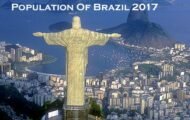Dar es Salaam is the biggest city of Tanzania and also biggest city in East Africa in terms of population. It is Tanzania’s most conspicuous city in media, music, arts and TV. It is the country’s main financial center with the Dar es Salaam Stock Exchange being the nation’s first and most imperative stock exchange market.

The city is the main landing point for most visitors who visit tourism territories in the country like Zanzibar and national parks. The city attracts a large number of tourists from all over the world and especially from European countries. The city also boasts of several attractions and points of interest for people visiting here with beautiful and scenic views.
POPULATION OF DAR ES SALAAM IN 2017:
Talking about population, in order to check out the population of Dar es Salaam in 2017, we need to have a look at the population of the past 5 years. They are as per the following:
- 2012 – 4.36 Million
- 2013 – 4.5 Million
- 2014 – 4.78 Million
- 2015 – 5 Million
- 2016 – 5.29 Million
Getting from the past data of Dar es Salaam from the year 2012-16, it has been noticed that there has been an increase of 1.06 Million in the past 5 years. Therefore, it has been seen that every year the population increases by 0.212 Million. Hence, the population of Dar es Salaam in 2017 is estimated to be 5.29 Million + 0.212 Million = 5.502 Million. So, the population of Dar es Salaam in the year 2017 as per estimated data = 5.502 Million.
DAR ES SALAAM Population 2017 – 5.502 Million(Estimated)
DEMOGRAPHY OF DAR ES SALAAM:
Around 33% of Tanzanians distinguish themselves as Christian, another third as Muslim. The other remaining population practice various indigenous religions. In rural places a few people express their confidence in an animistic religion. Hinduism and Buddhism are additionally found among the individuals from the Asian minorities. Swahili is a Bantu dialect and the principal language out here. It is the fundamental dialect of Dar es Salaam.
POPULATION DENSITY AND GROWTH OF DAR ES SALAAM:
The population density of Dar es Salaam is 3100 persons per square kilometer. In the year 1957, during the British rule, the port city of Dar es Salaam sat on the shoreline of present-day Tanzania. It had a small population of 128,000.
In any case, late years have conveyed incredible growth as well as modifications to Dar es Salaam. As far as yearly population growth, it’s poised to be Africa’s quickest developing urban center. It is estimated to grow by more than 85 percent by the year 2025 and could touch 21.4 million individuals by 2052. With a population increment of 5.6% for every year from 2002 to 2012, it is the third quickest growing in Africa after Bamako and Lagos.
FACTS ABOUT DAR ES SALAAM:
- It turned into the capital of a recently free Tanganyika in 1961 and proceeded as the seat of administration when Zanzibar and Tanganyika were converged to shape Tanzania in 1964.
- The general population are warm and friendly. Muslims, Hindus, Christians and other customary convictions live respectively in flawless agreement. There are a few mosques, places of worship and also some temples in the city. Dar es Salaam is quickly extending and suburbs are quick turning out to be a piece of the city.
- Dar es Salaam is for the most part safe. Be that as it may, one needs to take careful steps particularly during the evening. Abstain from carrying a lot of money. Be on the caution in daytime of pickpockets who might as a rule pick wallets or cell phones. In the event that you should, bolt your windows. Keep resources at home, Avoid voyaging alone particularly in remote spots.
- It is Tanzania’s most significant city for business as well as government. The city comprises of high groupings of exchange and different services contrasted with different parts of Tanzania, which has around 80 percent of its population in provincial zones.
- On a characteristic harbor on the Indian Ocean, it is the center of the Tanzanian transportation framework as the principle railways and a few expressways start in or close to the city.
Find Latest Dar es Salaam Population in 2018



